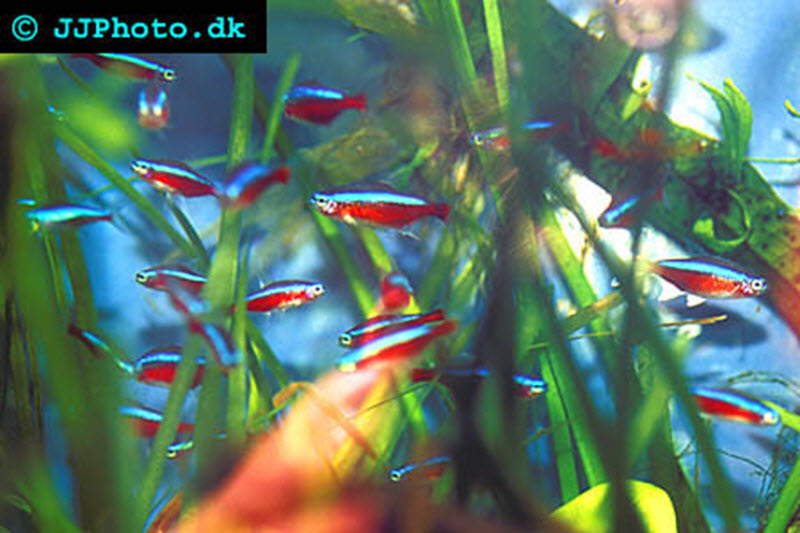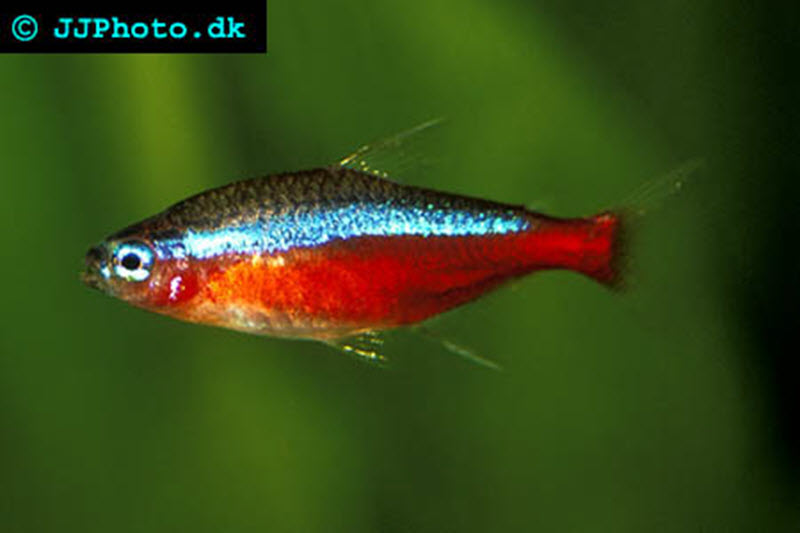Cardinal Tetra – Paracheirodon axelrodi
Contents
Cardinal Tetra information:
Scientific name: Paracheirodon axelrodi
Common name: Cardinal tetra
Max. size: 5 cm / 2 inch
pH range: 4.0 – 6.0
Temperature range: 23 – 27°C / 73.5 – 80.5°F
The Cardinal tetra is related to the immensely popular Neon tetra, and is frequently confused with it. The Cardinal tetra is however much more sensitive to poor water conditions and is generally not recommended for beginner aquarists.

Cardinal tetra picture. – Copyright www.jjphoto.dk
Cardinal Tetra habitat:
The wild Cardinal tetras live in the upper Orinoco and Negro rivers and are native to Colombia, Brazil and Venezuela on the South American continent. The Cardinal tetra spends most of its time in the middle water layer.
Cardinal Tetra description:
The Cardinal tetra is often confused with its immensely popular relative, the Neon tetra. Some people even refer to the Cardinal tetra as “red neon tetra”. They are however two distinct species and telling them apart is not difficult at all if you know what to look for. Both Cardinal tetras and Neon tetras feature a distinct iridescent blue line that bisects the body of the fish. Under this line, you will see a lateral red stripe. If you are looking at a Neon tetra, this stripe will end roughly halfway from the nose. If you are looking at a Cardinal tetra, the striping will continue much longer. The name Cardinal tetra is actually derived from this red colouration that extends throughout most of the Cardinal tetra’s body, since it was thought to resemble the long, red robe that covers a cardinal.
Cardinal Tetra setup:
When you set up an aquarium for Cardinal tetras it is always a good idea to include a lot of plants. An open area for swimming is also recommended. Floating plants that dim the light a bit will make your Cardinal tetras spend more time out in the open. Cardinal tetras should always be kept in groups consisting of at least five Cardinal tetras. Larger shoals are recommended, so if you have place for 10 Cardinal tetras or more you should definitely go for the higher number. Keeping only a few Cardinal tetras will result in shy and stressed fish. Cardinal tetras are non-aggressive and commonly kept in community aquariums with other peaceful tropical fish species of similar size. The Cardinal tetra is a good choice if you are looking for fish that will occupy the top and mid part of the aquarium.
The recommended minimum aquarium size for cardinal tetras is 60 centimetres (24 inches). Cardinal tetras are more sensitive to poor water conditions than the Neon tetras, and it is always easier to maintain a high and stable water quality in a large aquarium than in a small one. Getting an aquarium that is large enough is especially important for beginner aquarists that wish to keep Cardinal tetras. If you are a skilled aquarists that knows how to maintain perfect water conditions, it is however possible to keep Cardinal tetras in aquariums no larger than 20 litres (5 gallons).
Cardinal Tetra care:
As mentioned above, the Cardinal tetra is more sensitive than the Neon tetra when it comes to water quality. The Cardinal tetra is particularly sensitive to nitrate, but the levels of ammonia and nitrite must also be kept down. Frequent water changes should be carried out and food should never be left uneaten in the water. Cardinal tetras are generally not recommended for beginner aquarists, but if you are serious about keeping Cardinal tetras and prepared to closely monitor the water conditions you can keep Cardinal tetras even as a beginner.
When it comes to water chemistry, you should try to make the conditions in the aquarium similar to Rio Orinoco and Rio Negro. These South American rivers are renowned for their extremely soft and acidic water. The pH in the aquarium should therefore ideally be kept between 4.0 and 6.0. It is possible to gradually adapt Cardinal tetras to harder conditions and even alkaline water, but living in such an aquarium will make the Cardinal tetra more sensitive and less resilient towards illness. The water temperature should between in the 23 – 27° C (73.5 – 80.5° F) range. You can adapt the Cardinal tetra to a slightly higher temperature without weakening it if you allow the transition to be slow and gradual.
Cardinal Tetra feeding:
Wild Cardinal tetras feed on small crustaceans and worm. They will usually accept most types of food in the aquarium and display a healthy appetite. You can for instance use a high-quality tropical flake food as a base and also include small worms in their diet. A varied diet will decrease the risk of malnutrition.
Cardinal Tetra breeding:
Cardinal tetras have been successfully bred in captivity, but breeding them is quite difficult and a majority of the Cardinal tetras sold in pet shops are therefore wild caught from Rio Orinoco and Rio Negro. In the wild, they are however highly prolific and they are not considered threatened in their native region. In this regard the Cardinal tetra differs from the Neon tetra which is a highly prolific species not only in the wild but also in captivity. Wild Cardinal tetras have a natural life span of no more than one year, and they are therefore capable of spawning while still being very young. (When you keep Cardinal tetras in aquariums they can live for several years.)
If you want to try breeding Cardinal tetras you must provide them with ideal water conditions. Switch from flake food to plenty of live food and include fine leaved plants in the aquarium set up. The Cardinal tetra is a non-guarding open water/substratum egg scatterer that will prefer to deposit the eggs among plants. Over 500 eggs can be released in one spawning. The eggs will hatch after 24-30 hours and it will then take an additional 3-4 days before the fry are free-swimming. Really small fry-food is necessary since the miniscule Cardinal tetra fry can not handle large food types.
The fry are very sensitive to poor water conditions and you can expect very high death rates if you do not keep the water quality at supreme levels. Another threat is the adult fish. Since Cardinal tetras are non-guarders, they will not hesitate to eat eggs and fry. If you want to breed Cardinal tetras it can therefore be a good idea to set up a separate fry rearing aquarium.
